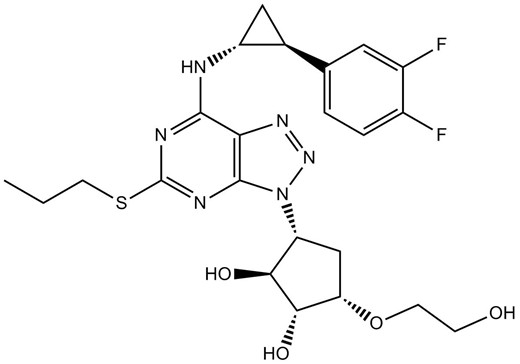

Ticagrelor
API’s Name:Ticagrelor
CAS No.:274693-27-5
Indication:Anticoagulant
Innovator:
Specification:In-House
US DMF:28984
EU DMF:√
CEP:
Only for R&D purpose
Product Detail
Intermediates
| Code | CAS | Specification |
| TG A | 155899-66-4 | In-House |
| TG A-4 | 376608-65-0 | In-House |
| TG B | 145783-14-8 | In-House |
| TG B-1 | 145783-15-9 | In-House |
| TG C盐酸盐 | 1156491-10-9 | In-House |
| TG C扁桃酸盐 | 376608-71-8 | In-House |
Background
Ticagrelor is a novel antagonist of the P2Y12 receptor [1].
Ticagrelor has been reported to inhibit the prothrombotic effects of ADP on the platelet by against the P2Y12 receptor. Ticagrelor has shown the complete inhibition of platelet aggregation ex vivo. In addition Ticagrelor has suggested a dose-dependent inhibition of platelet aggregation in human being. Apart from these, Ticagrelor has also demonstrated an orally, actively, reversibly binding antagonist. Unlike other inhibitors, Ticagrelor has also reported to inhibit P2Y12 receptor without metabolic transformation. Besides that, Ticagrelor is the first thienopyridine anti-platelet agent and mainly metabolized by CYP3A4 and CYP2C19 [1][2].
References:
[1] Zhou D1, Andersson TB, Grimm SW. In vitro evaluation of potential drug-drug interactions with ticagrelor: cytochrome P450 reaction phenotyping, inhibition, induction, and differential kinetics. Drug Metab Dispos. 2011 Apr;39(4):703-10.
[2] Li Y1, Landqvist C, Grimm SW. Disposition and metabolism of ticagrelor, a novel P2Y12 receptor antagonist, in mice, rats, and marmosets. Drug Metab Dispos. 2011 Sep;39(9):1555-67. doi: 10.1124/dmd.111.039669. Epub 2011 Jun 13.
Description
Ticagrelor (AZD6140) is a reversible oral P2Y12 receptor antagonist for the treatment of platelet aggregation.
In Vitro
Ticagrelor promotes a greater inhibition of adenosine 5′-diphosphate (ADP)–induced Ca2+ release in ished platelets vs other P2Y12R antagonists. This additional effect of ticagrelor beyond P2Y12R antagonism is in part as a consequence of ticagrelor inhibiting the equilibrative nucleoside transporter 1 (ENT1) on platelets, leading to accumulation of extracellular adenosine and activation of Gs-coupled adenosine A2A receptors[1]. B16-F10 cells exhibit decreased interaction with platelets from ticagrelor-treated mice compared to saline-treated mice[2].
In B16-F10 melanoma intravenous and intrasplenic metastasis models, mice treated with a clinical dose of ticagrelor (10 mg/kg) exhibits marked reductions in lung (84%) and liver (86%) metastases. Furthermore, ticagrelor treatment improves survival compared to saline-treated animals. A similar effect is observed in a 4T1 breast cancer model, with reductions in lung (55%) and bone marrow (87%) metastases following ticagrelor treatment[2]. Single oral administration of ticagrelor (1-10 mg/kg) causes dose-related inhibitory effect on platelet aggregation. Ticagrelor, at the highest dose (10 mg/kg) significantly inhibits platelet aggregation at 1 h after dosing and the peak inhibition is observed at 4 h after dosing.
Storage
4°C, protect from light, stored under nitrogen
*In solvent : -80°C, 6 months; -20°C, 1 month (protect from light, stored under nitrogen)
Chemical structure


